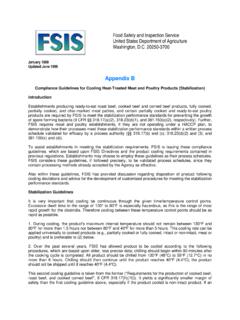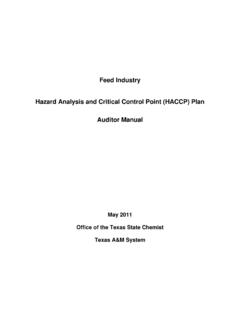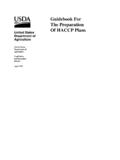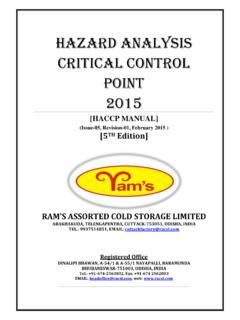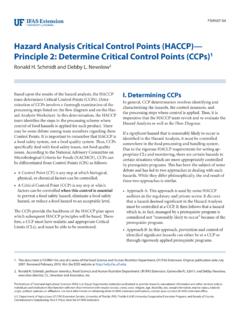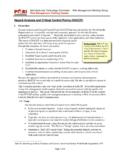Transcription of HACCP - Hazard Analysis and Critical Control Points
1 1 BARE-BONES OVERVIEW OF HACCP By Dr. Dennis Buege HACCP - Hazard Analysis and Critical Control Points The HACCP approach to food safety emphasizes the following actions in addressing potential hazards : Prevention Control Documentation (Record Keeping) It is the primary goal of every food processor to prevent the development of bacterial, chemical or physical hazards in the food they produce. Prevention is best achieved by controlling the processing environment and procedures to keep food safe. Documentation, or keeping records of actions taken at key steps in the process assures that proper Control measures were applied, and provides the evidence to prove it.
2 Plant employees are already using many prevention and Control steps to produce safe food. These practices are also the heart of food safety under HACCP . HACCP is similar to Sanitation Standard Operating Procedures (SSOP s) in that you: describe in writing what you are going to do to produce safe food carry out those actions during production record observations or measurements at key steps verify that you are operating your system as you said you would HACCP is a plant s program, developed and operated by the plant. Much of Inspection Service activities under HACCP will consist of verifying that you are following your HACCP program, and keeping records of what you have done.
3 Although the prevention and Control approach of HACCP may also lead to improvements in quality and economic factors in food processing, HACCP itself only addresses food safety. The HACCP system operates around 7 principles in controlling hazards in food production: 1. Conduct a Hazard Analysis of the process. 2. Identify Critical Control Points (CCP s) in the process. 3. Establish Critical Limits for preventative measure(s) at each CCP. 4. Monitor CCP s to determine if they re in Control . 5. Establish Corrective Actions to be taken when Critical limits aren t met.
4 6. Establish an effective Record Keeping System. 7. Establish procedures to Verify that the HACCP system is working. The following pages provide simple descriptions of steps in developing a HACCP program, and examples of some of these steps. 2 ORGANIZING AND OPERATING YOUR HACCP SYSTEM The steps often followed in moving into a HACCP system include: 1. Decide who will lead the development of the HACCP program (the HACCP team). What resources do you need to help develop the program? Learn as much as you can about HACCP from industry publications, training programs, other processors, and inspection personnel.
5 Bring employees into the process. 2. Which HACCP plans need to be developed? Products produced in a relatively similar manner can be combined into a single HACCP plan. What can be combined is determined by the product type, and how they are manufactured in your plant. The USDA has identified categories into which like products or procedures can be combined into a single HACCP plan. These include: Slaughter - all species (beef, swine, poultry) Raw - not ground (cuts of beef, pork) Raw - ground (ground beef, fresh sausage) Fully cooked - not shelf stable (wieners, ham, roast beef) Heat treated - shelf stable (jerky, snack sticks) Heat treated - not fully cooked (bacon) 3.
6 Determine the prerequisite programs that are needed to support your HACCP program. Standard Operating Procedures (SOP s) and Good Manufacturing Practices (GMP s) describe in writing the important steps and practices you and your employees will take in producing safe food. SOP s and GMP s support HACCP and are an important part of the HACCP system. They are often described as Prerequisite Programs for HACCP . Effective SOP s and GMP s are preventive and controlling measures which can make potential hazards unlikely to occur. SOP s and GMP s must be written down (clearly and simply), and where appropriate records should be maintained to document their effectiveness.
7 SOP s and GMP s may be applied in the following areas to support the HACCP system: Sanitation ( SSOP s ) o Pre-operational Sanitation - cleaning and sanitizing o Operational sanitation- personal hygiene and food handling practices. Receiving of meat and non-meat ingredients. Controlling temperatures in coolers, freezers and processing areas. Storage of meat and non-meat ingredients (including temperature Control ). Building and equipment maintenance. Weighing of restricted ingredients (such as nitrite). Handling and packaging of ready-to-eat products (separation of raw and cooked).
8 Several examples of SOP s are provided on the following pages. 3 Receiving and Storage Standard Operating Procedures XYZ Company Meat 10. Plant will only accept product from an approved source. 11. All containers are inspected for visible contamination, or damage to package that may allow contamination. - Reject any contaminated/damaged product and return to supplier.
9 3. Check temperature of incoming meat products (2 boxes/load) - Record temperatures on incoming meat invoices. - Reject meat products that are more than 50oF or evaluate product and cool rapidly. 4. Product is to be placed in cooler or freezer immediately on racks approved for specific products. 5. All invoices are checked, initialed and kept on file for review by meat inspection personnel. Non-Meat Ingredients 1. Only accept products from approved sources. Letters of guarantee kept on file by plant. 2. Date containers upon arrival and check for damage or contamination.
10 3. Reject containers that are not acceptable and return to suppliers. 4. Store all meat additives in approved areas. 5. Document receiving by initialing and filing invoices in plant s file. Packaging Materials, Cleaning Supplies etc. 1. Accept only products from approved sources. A. Letters of approval or USDA codes kept on file. B. Invoices initialed and kept on file for review. 2. Inspect all products for condition and integrity. Reject any damaged goods and return to supplier. 3. Date containers or materials upon arrival. 4. Store in approved areas and rotate stocks for freshness.





